Working Together
After a lifetime of playing board games I only recently have been introduced to a genre of the hobby, the cooperative board game. It’s funny that the idea seemed so revolutionary to me when I first heard about it considering that I’ve played cooperative video games for years. You and a few friends play together against the game. It’s a simple idea.
The concept generally works very well. You still get a feeling of competition while playing but it doesn’t come with the same level of aggression that can strain friendships in other games. Most cooperative games require a high level of strategy as players coordinate moves and actions with each other. A lot of cooperative board games are hard to beat resulting in a nice joint sense of satisfaction when you win together.
One sticking point of cooperative board gaming is that it needs players who are able to work together. It’s an obvious statement but a session will quickly fall apart if players aren’t supportive of each other. This can be especially difficult when playing with new players. Someone new to a game may be overwhelmed with indecision and will too easily defer to other people’s opinions about what they should do during their turn. It’s important to make sure everyone feels involved in the game and that it’s not being taken over by a couple people.
As I’ve played more and more cooperative games, five in particular have emerged as my favorites. Each brings a very different experience and can be counted on for a challenge.
5. Red November
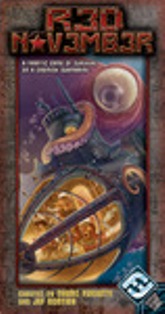
In the co-op board game Red November, players are the gnome crew of a submarine in trouble. Fires, floods, rising pressure, a shrinking supply of oxygen, and even drunkenness plague the ship and players must hold off disaster until help arrives.
Each action a player takes uses up a finite amount of time and decisions must be made carefully. Do you spend the minutes needed to pry open a stuck door to a room on fire or do you head to the other end of the ship to fix the oxygen pumps? If you do open the door, does your gnome have the liquid courage (vodka) to face the inferno? And if he does, does he pass out from imbibing too much? There’s a time track around the board and if players can survive long enough the game is won.
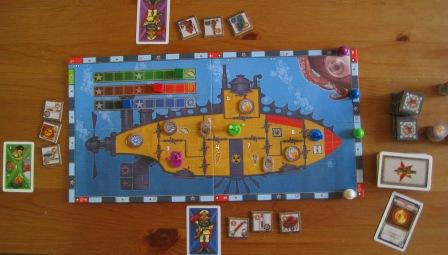
Red November is lost when one of three disaster tracks reaches its end – heat, oxygen and pressure. Along with these “minor” troubles are “timed destruction” events in which players have a limited amount of time to address major catastrophes like the submarine’s warheads launching or a giant Kraken attack. All problems can be fixed with time and special items can be found to shorten the time needed to do so. However, eventually problems start occurring faster and more often, leaving less room for inefficient movement.
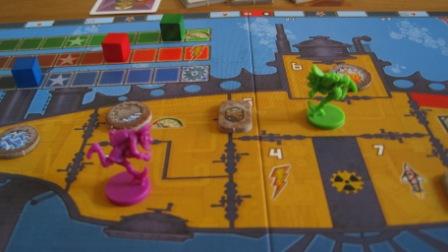
Red November suffers from a few flaws, one being that it is a few turns too long, especially when several people are playing; up to eight people can play. And after a while the disasters that pop up get a little repetitive. I think if the overall game time limit was a little shorter Red November would feel more action packed.
Another problem is that special items can make a major difference in dealing with catastrophes and when a player doesn’t have a requisite item their turn can feel lost. It gets back to one of the necessary parts of co-op gaming; everyone playing has to feel involved in the game or it won’t work.
My final criticism is that the board was made to fit in a tiny box—nice for transporting the game but not so great when playing with several people. It’s hard to squeeze around such a tiny space. Some people have made their own, bigger board which is something I’m definitely thinking about doing.
These shortcomings aside, Red November is a fun game. You can’t beat the theme of a bunch of drunken gnomes running about a leaking, calamitous submarine. While playing I can’t help but imagining the submarine being filled with strange smells, water continuously spouting from portholes, small explosions constantly going off, its captain drunkenly stumbling down the corridor, and other elements you’d associate with the atmosphere of a gnomish craft. I like the time-spending mechanic of the game as well. You essentially have unlimited actions in a turn but you’ll pay for spending too much time. Players need to coordinate with each other and use their time wisely.
Red November is a fun cooperative board game but its few blemishes keep it from being my most favorite. I still would recommend that board game lovers give it a try keeping what I’ve said in mind.
4. Space Alert
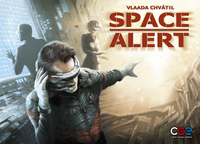
Space Alert is a cooperative board game with a very unique system of play. Up to five players make up the crew of a space ship. While exploring the dangerous outer reaches of the universe the ship’s scanners indicate that danger is imminent. The focus of the game is simple, protect the ship until it can safely get away from the threat. What makes Space Alert stand out is its short play time—the part of the game where players plan their actions and movements actually only lasts ten real-time minutes. Then based on the decisions the players made in that time, the game is played out and it’s seen if they made the right choices.
A ten-minute-long CD “soundtrack” is played which has the ship’s central computer declaring different phases. The computer voice also makes other announcements about malfunctions happening on the ship, alien ships appearing, opportunities for players to trade cards, and many other things.
During this time players must place movement and action cards along their own track – twelve spaces in all. Actions constitute manning guns, raising shields, and managing energy supplies. Other movement based actions allow the players moving their pieces around the ship.
For example, if your intent is to fire the left-most lasers you must play the movement cards necessary to get yourself there (let’s say it took three cards to get there). Then in the fourth slot place a card that activates and fires the lasers. But the weapons first need energy or they’ll misfire. You need someone to get to the energy system before you fire the lasers on your fourth action.
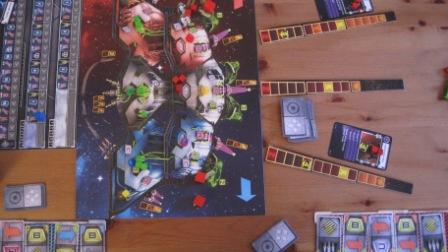
Once this period has ended the players may do nothing else. The numbered sections on each player’s track are then played out step by step through all twelve actions. Back to my laser example, if your comrade didn’t get to the energy stores in time, your actions are wasted as the lasers are unable to fire. If at the end of all this, the ship hasn’t been destroyed, the players win.
Space Alert is not a game for the faint of heart. Those ten minutes of decision making are utterly terrifying and go by in an instant. The first time I played, my friends and I were completely frozen with indecision. I think the only decision I made with confidence was my declaration of peeing my pants. Trying to coordinate actions with your shipmates is difficult with the computer constantly shouting new emergencies. Every action needs to be precisely organized. It does no good to raise the ship’s shields if no energy for them has been loaded in the ship’s lower level. And as I said before, there’s no going back – once you’ve set down your action cards you cannot adjust them. The hardest part is that your actions aren’t played out until all have been laid down and the ten minutes are over – only then do you find out if you’re successful. We lost the first game pretty badly.
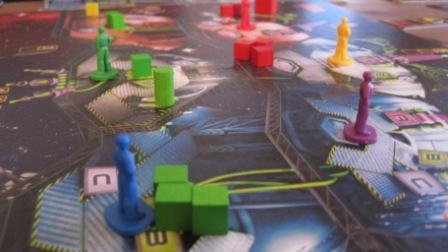
The second time we played was much better as we talked about what to do and assigned tasks to each other before we started playing the CD. The game was nevertheless ugly as we were still working our way through how to man the ship’s defenses efficiently. Later sessions got better and better though I’ve yet to beat the game.
Space Alert is not a game for casual players. The ship’s crew is only as strong as the weakest player. Everyone playing needs to be supremely involved or you’ll never win. Also unlike other co-op board games I’ve played, you need someone to be a leader; someone to guide the players and be the focal point for coordinating everyone’s actions. Having one person in charge takes a close-knit group of players who are willing to listen and take orders; not something that can be done with every gaming group.
Since I’ve only played a few times my opinion of Space Alert might be lowered or raised with future sessions. I’d love to dedicate more time to the game and play with other people who are just as determined to beat it. The game is appealing to me as it forces real-time decision making and crisis management. The atmosphere of panic and danger in Space Alert is unlike any game I’ve ever played. Space Alert isn’t a game that will be pulled off the shelf very often but when it is, you’re guaranteed thrilling action and drama.


Both games are fun, but Space Alert gave me a panic attack the first time we played. I really felt like we were on the CS deck in BSG preparing to jump from the cylons.
Red November was good times, but I can see it being easily frustrating if your gnome gets wasted and has to sit out a few rounds to sober up. And you’re right, too bad the board is so small. They should make a larger, deluxe model.
Agreed on all counts – looking forward to hearing more of what you have to share!